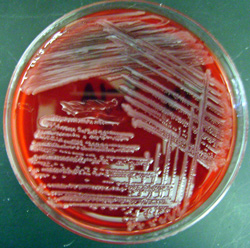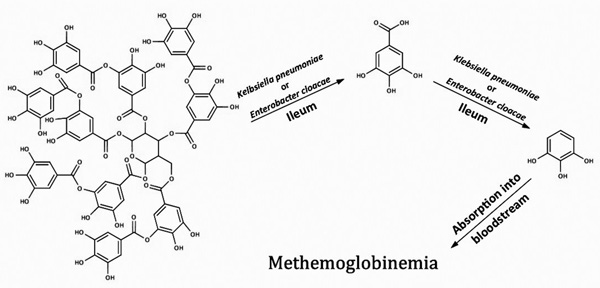Red Maple Toxicosis
Background

Acer rubrum (Red Maple) is a deciduous tree native to northeastern North America and commonly found near pastures. The leaves of A. rubrum, especially when wilted in the fall, cause severe oxidative damage to equine erythrocytes, leading to potentially fatal methemoglobinemia. Gallic acid and tannins from A. rubrum leaves have been implicated as the toxic compounds responsible for Red Maple Toxicosis (Boyer et al, 2002), but this study found that pyrogallol is a more potent inducer of methemoglobinemia.
Key — A: Tannic Acid (200 µg/mL), B: Gallic Acid (200 µg/mL), C: Pyrogallol (25 µg/mL), D: Pyrogallol (50 µg/mL), E: Pyrogallol (100 µg/mL), F: Pyrogallol (200 µg/mL), G: Catechol (200 µg/mL), H: Ferulic Acid (200 µg/mL), I: p-Coumaric Acid (200 µg/mL), J: trans-Cinnamic Acid (200 µg/mL), K: Control blood sample.
Hypothesis & Objectives
Given that the conversion of gallic acid to pyrogallol involves a decarboxylation reaction, and the literature suggests a microbial basis for the metabolism of tannins to gallic acid and subsequent pyrogallol production, it is hypothesized that the hydrolysable tannins and free gallic acid in in A. rubrum leaves are protoxic and undergo metabolism to the oxidative agent pyrogallol as outlined above. The objective of this study is to isolate and identify compounds in A. rubrum capable of inducing toxicosis in equids and elucidate their mechanism of action.
Results
Gallic acid was metabolized to pyrogallol most consistently in the equine ileum in the first 24 hours. Incubation of tannic acid with ileum contents produced gallic acid, and subsequently pyrogallol. The same pathway was observed using A. rubrum leaves. Unfiltered suspensions of ileum incubated with gallic acid demonstrated pyrogallol formation, but filtered suspensions did not, suggesting a microbial metabolic pathway. Bacteria isolated from the ileum capable of forming pyrogallol from maple leaves were identified as Klebsiella pneumoniae and Enterobacter cloacae.

Figure 2. Enterobacter cloacae. Credit: Karan Agrawal
Conclusions and Clinical Relevance
Gallotannins and free gallic acid are present in A. rubrum leaves and are metabolized by K. pneumoniae orE. cloacae in the equine ileum to form pyrogallol either directly or through a gallic acid intermediate (gallotannins).
Identification of these compounds and their physiological effects is necessary for the development of effective treatments for red maple toxicosis in equids and camelids.

Figure 3. Proposed pathway for red maple toxicosis in equines.
References
- Boyer JD, Breeden DC, Brown DL. Isolation, identification, and characterization of compounds from Acer rubrum capable of oxidizing equine erythrocytes. Am J Vet Res 2002;63:604–610.
- George LW, Divers TJ, Mahaffey EA, et al. Heinz body anemia and methemoglobinemia in ponies given red maple (Acer rubrum L.) leaves. Vet Pathol 1982;19:521–533.
- Alward A, Corriher CA, Barton MH, et al. Red maple (Acer rubrum) leaf toxicosis in horses: a retrospective study of 32 cases. J Vet Intern Med2006;20:1197–1201.


